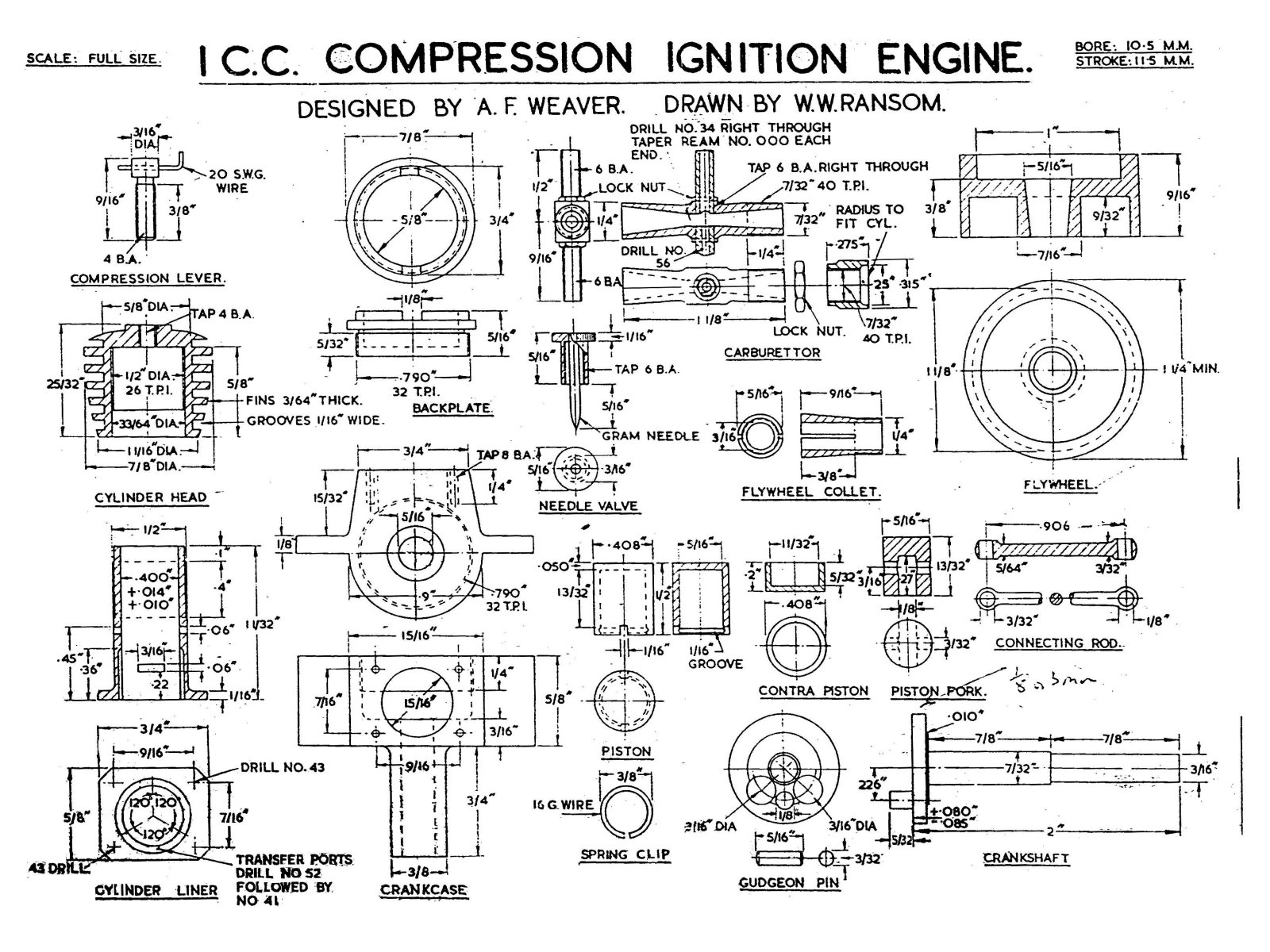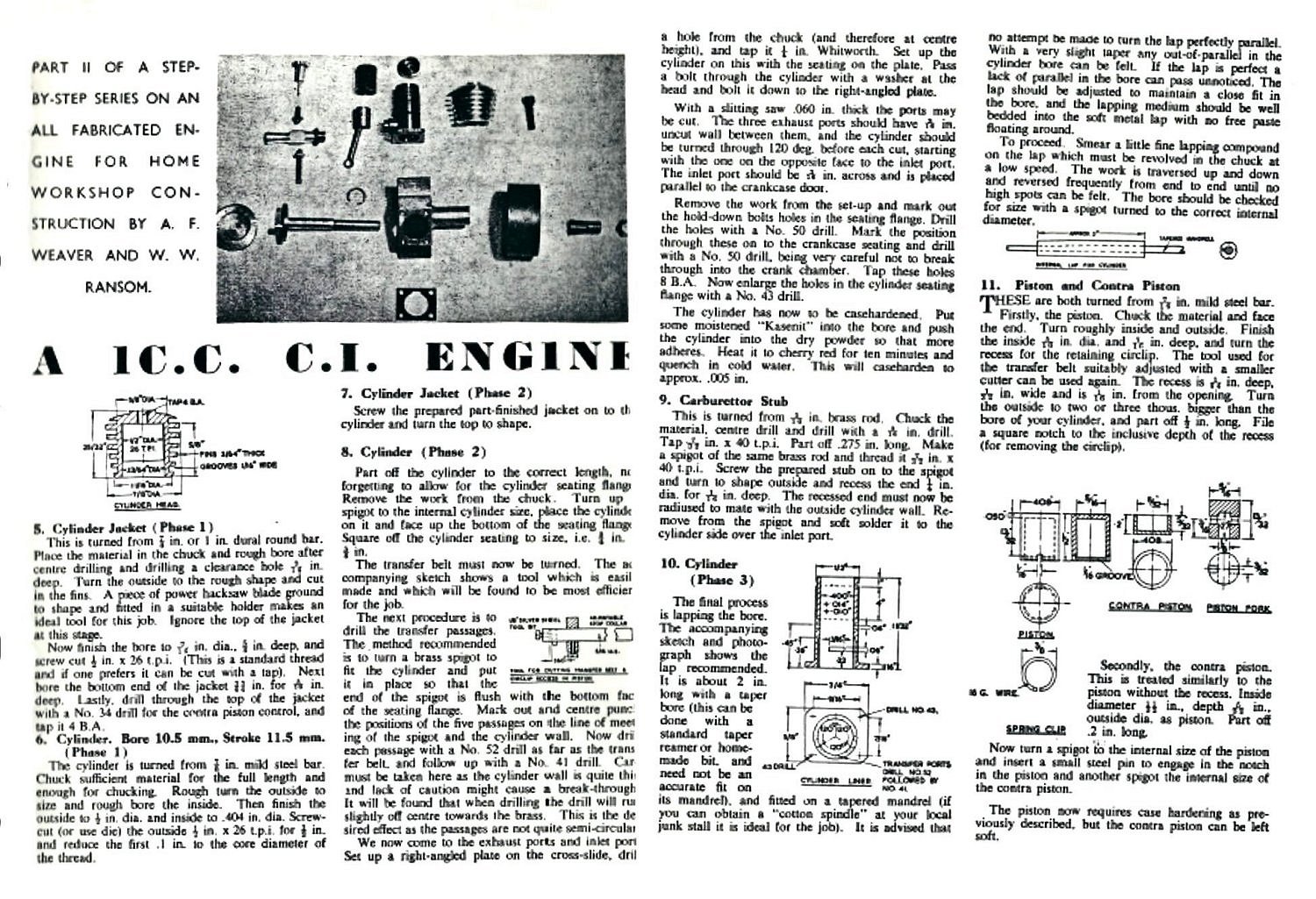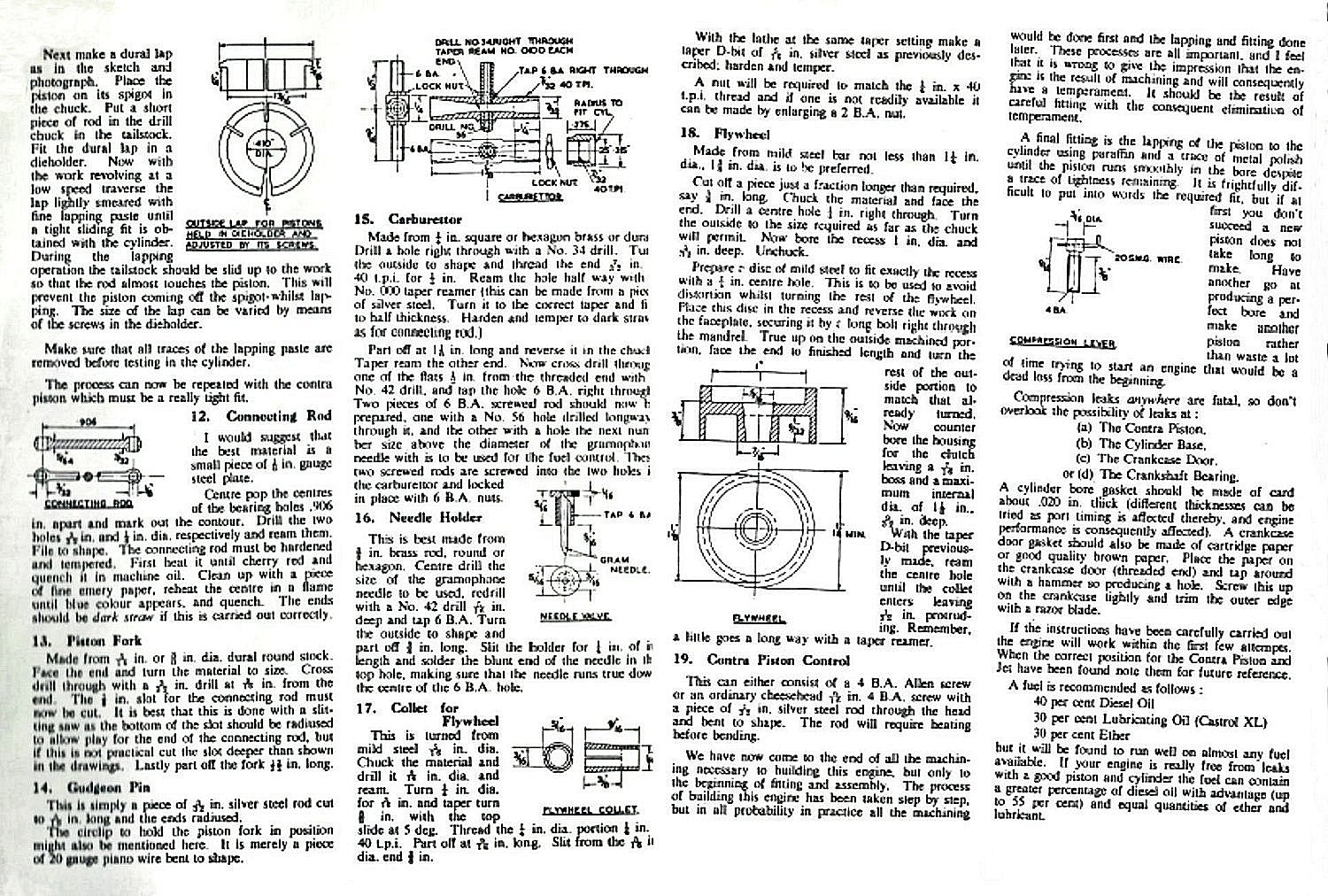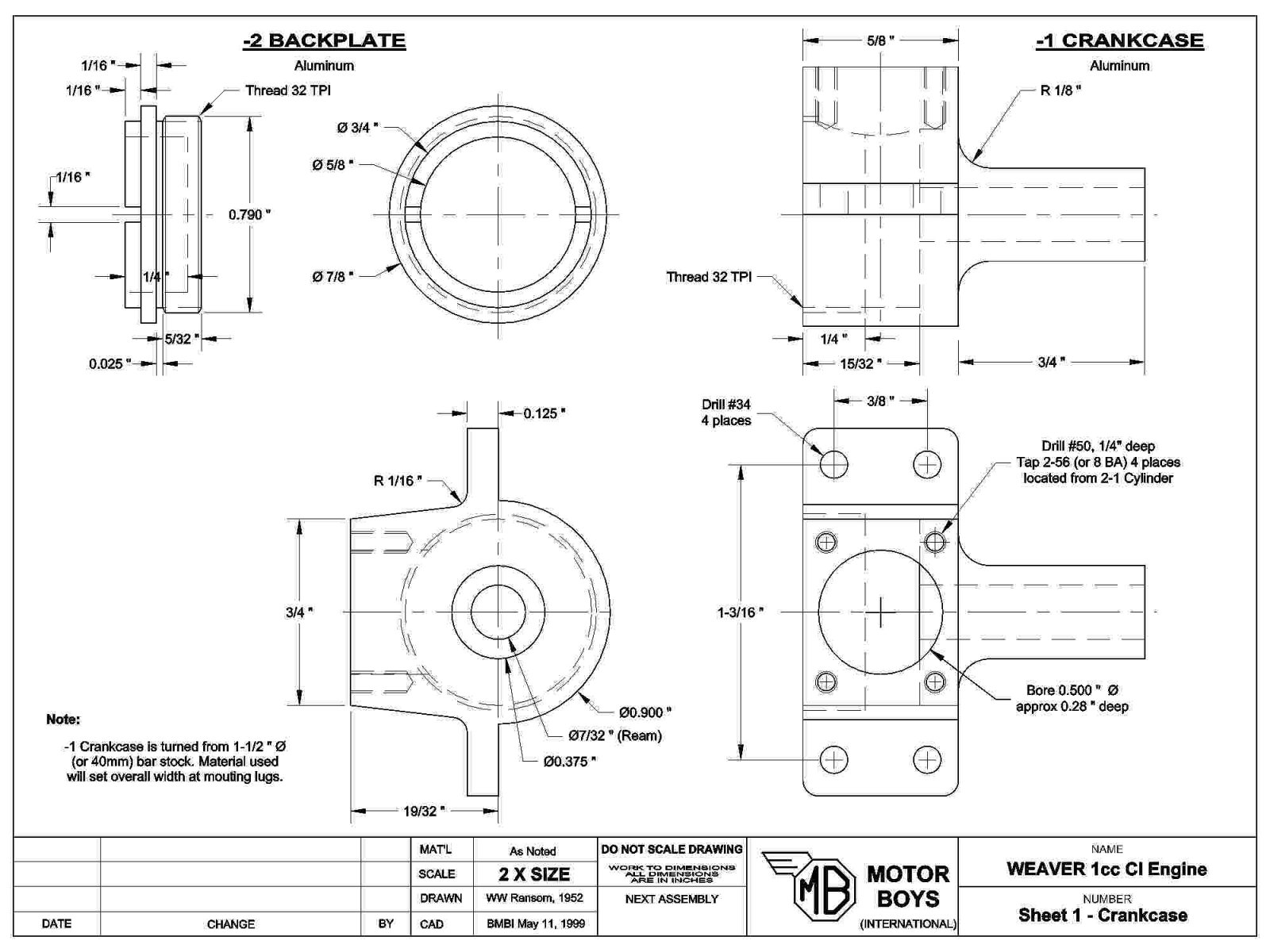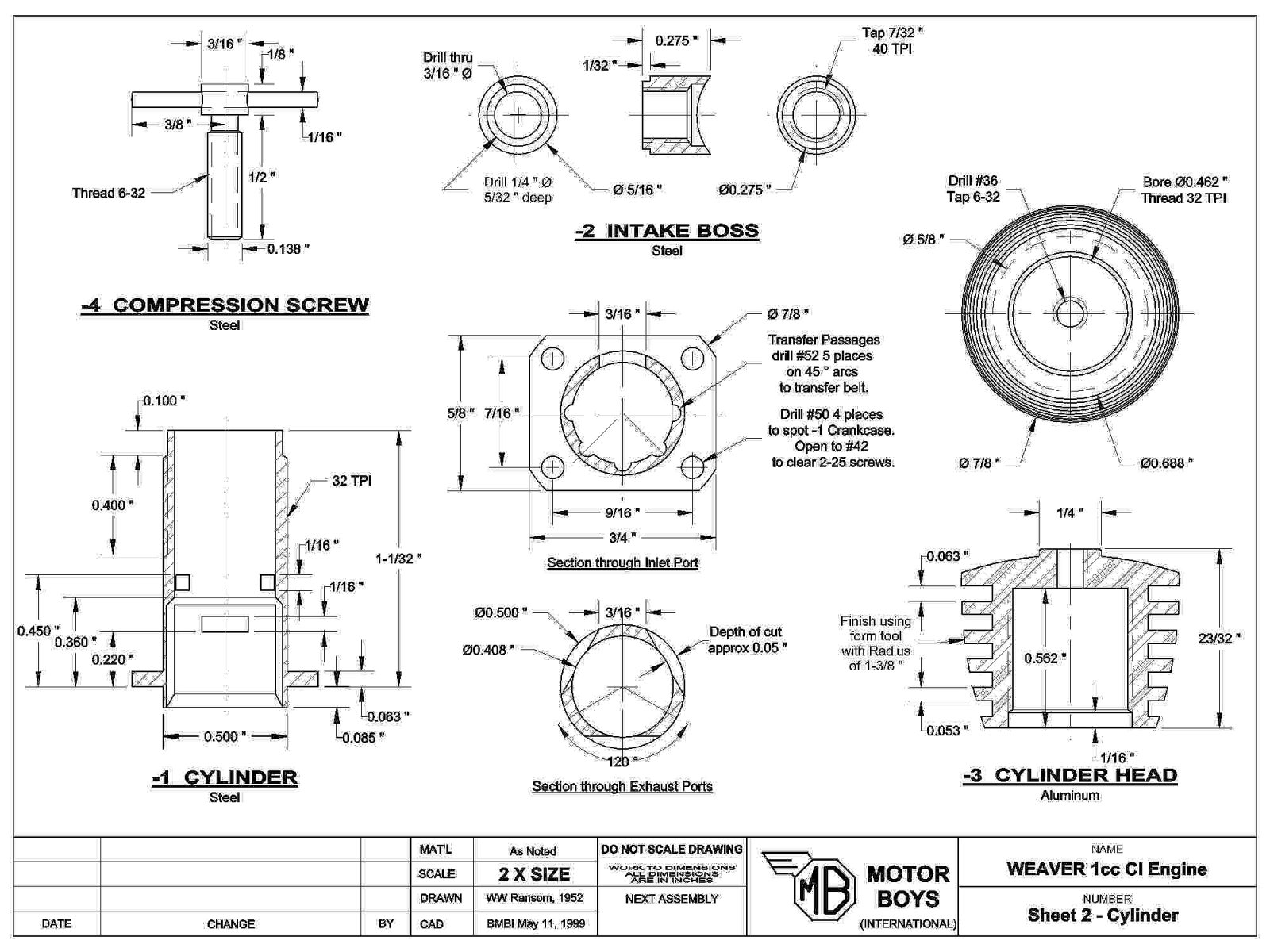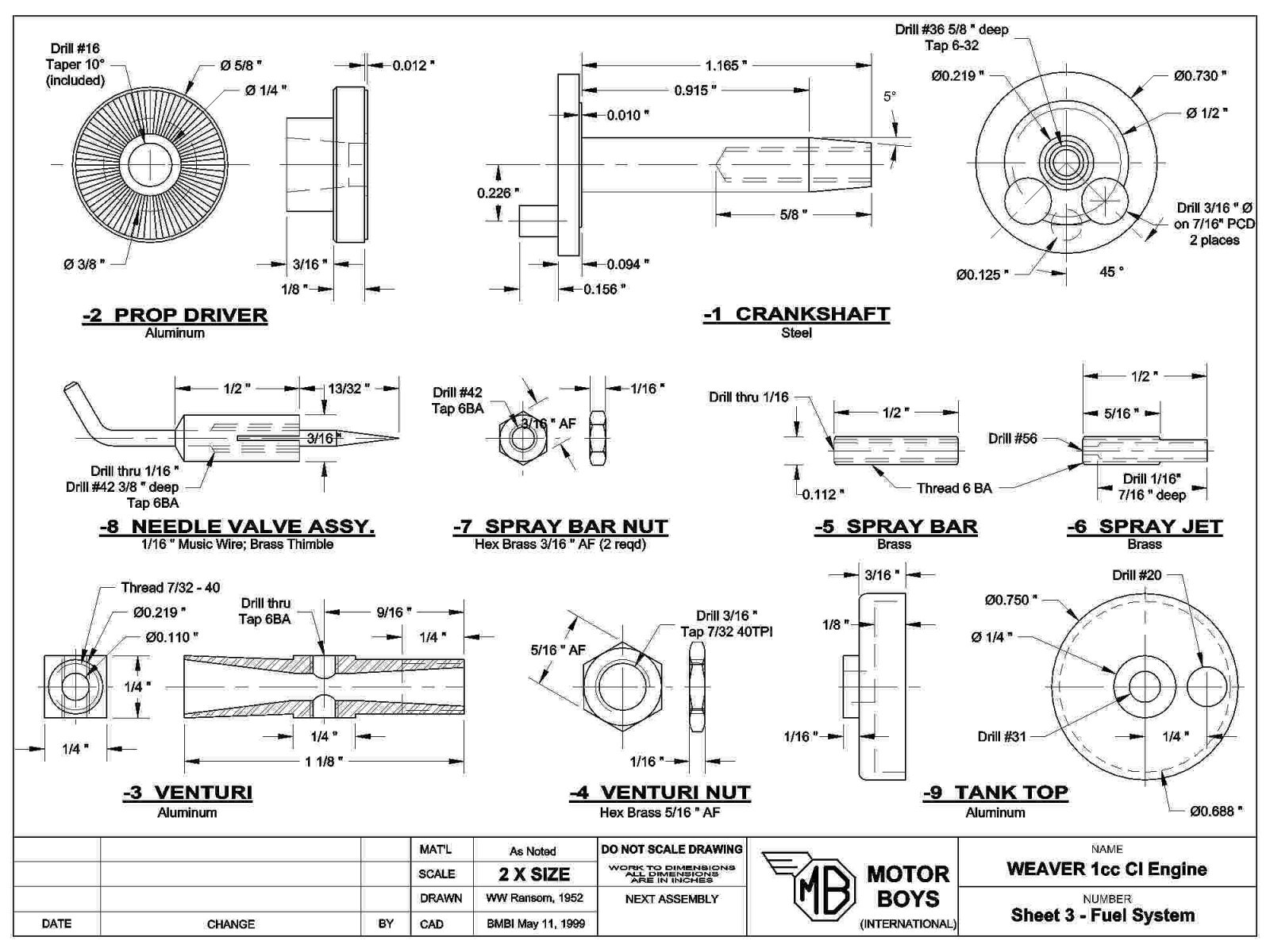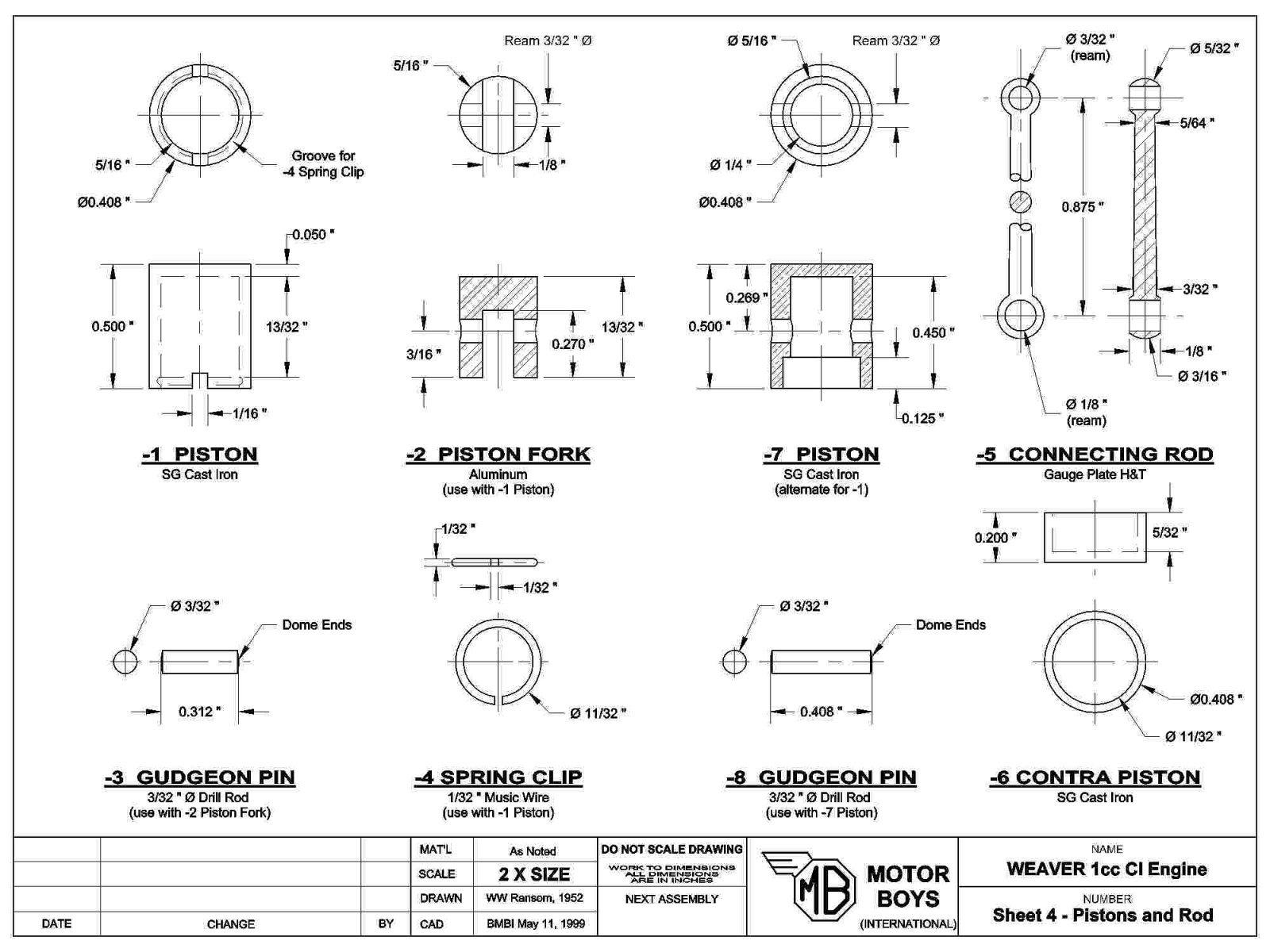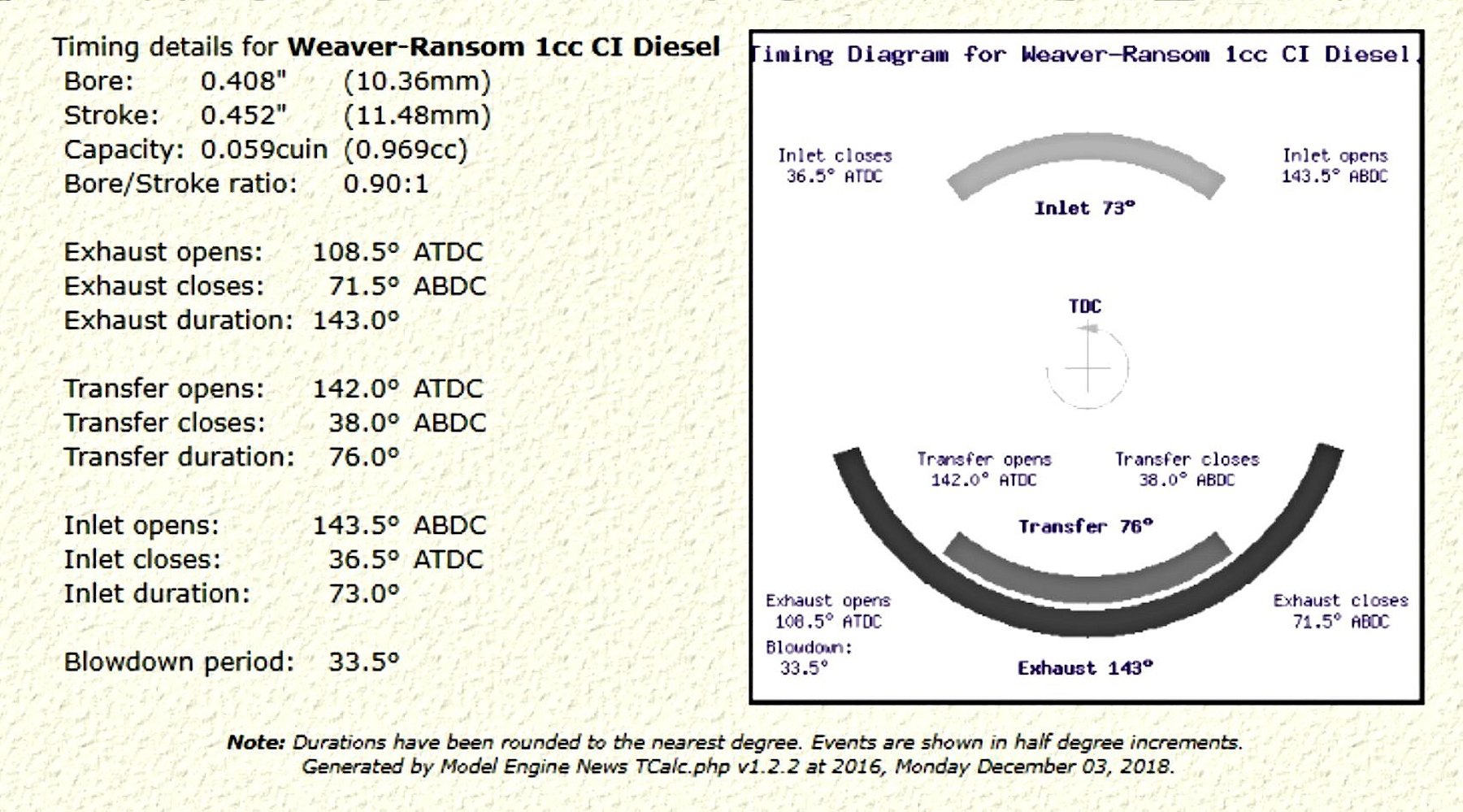
|
|
A Classic Home Construction Project - the Weaver 1 cc Diesel
This excellent little model diesel presents an enjoyable and not overly-complex construction challenge for the amateur home constructor. My main purpose in publishing this article and the attached plans is to encourage the construction of further examples. We can't have too many of these lovely little units! The Weaver 1 cc diesel is far more than an attractive subject for home construction - it is also a highly satisfactory powerplant for use in classic models. Ken Croft, who is among the many individuals who have built and flown examples of the engine, says that the Weaver is quite a powerful unit for a 1 cc diesel of its time. As an example, Ken says that it develops far more power than required to fly the classic 1950 Vic Smeed "Tomboy" design (a combination which Ken has tried himself).
A detailed series of articles about Arthur Weaver and his models may be found on the outstanding and highly recommended “On The Wire” website which is dedicated to preserving the history of tethered car and hydroplane racing. For convenience, I’ll summarize a few of the main points of interest here to set this lovely little engine in its proper context. Arthur Weaver came by his expertise honestly – he had a long and varied hands-on career in the engineering field. Born in 1904, he was just 5 years old when Louis Bleriot flew the English Channel. This event seems to have made a very strong impression upon the young boy, since some time later at the age of 12 he built a fine model of Bleriot’s aircraft which was exhibited in his school for a number of years. He was to maintain a lifelong interest in modelling.
Arthur also enjoyed motorcycling and owned a Norton motorbike, which he doubtless tuned to perfection. Proving the old adage that it's an ill wind which blows nobody any good, it was a motorcycle accident which landed him in Whips Cross Hospital that led to Arthur meeting his future wife Mary, who worked as a night nurse at the hospital. They were married in 1932.
After the war ended, the family remained in Hendon. While his wife continued her nursing career at nearby Colindale Hospital, Arthur went to work for the Armstrong Cork Company on Honeypot Lane in Kingsbury. There he helped to design machinery for inserting the cork sealing pads into the crown caps produced by the company. It was around this time that he started designing and constructing model engines and building model cars in addition to hydroplanes. By 1950 the cars had evidently become his predominant modelling interest. Arthur quickly became well-known in modelling circles for his beautifully-made scale and semi scale cars. He was to go on to become a leading exponent of rail car racing into the 1950s. He continued to work at Honeypot Lane until 1953, when he joined Dennis Allen and Len "Stoo" Steward in becoming involved with the reorganized AMCO manufacturing operation at Alperton. He remained there until AMCO production finally ceased in early 1955, as recounted elsewhere. After that, he went on to a range of other activities, many of them involving models. He died somewhat prematurely in 1973 at the age of 68. Arthur was a regular contributor to the various specialist modelling magazines, writing or contributing to articles on a range of topics. It was one of these submissions that first introduced our main subject, the Weaver 1 cc diesel. In June 1952, the British magazine "Model Maker" commenced a series of articles entitled “A 1 c.c. C.I. Engine”. This three-part series described the construction of a simple 1 cc sideport compression ignition (aka "diesel") engine which had been developed over a period of several years by Arthur Weaver specifically for use in rail car racing. The series was authored by W. W. "Bill" Ransom, a friend and fellow club-mate of Arthur Weaver. According to Ransom's own account as set out in the first of his three articles, he had never previously built a model diesel, having been initially put off the idea of doing so by the somewhat cautionary tone of a number of previous articles on model diesel construction which stressed the difficulties involved. However, having built his first car and wishing to power it with a home-constructed engine, he discussed his problem with Arthur Weaver, who showed Ransom the latest version of his self-designed 1 cc diesel which he had been running successfully in a rail-guided car for some time. The result of this discussion was that Ransom drew up a plan for what was to become known as the Weaver 1 cc diesel and proceeded to construct his own example in consultation with Arthur Weaver, recording his construction methods as he went along. Ransom subsequently worked this record into the three-part article series through which the engine was introduced to the model engineering world. Ransom's plan for the engine was included. That plan is reproduced below along with Ransom's series of construction articles. Both plan and construction article were subsequently made available as a set through the Model Maker Plans Service as Plan no. MM/251.
The engine was deemed by the magazine to be particularly suitable for home construction since it could be built entirely without the use of castings. That didn’t stop the late Roger Schroeder from producing a batch of crankcase castings for the engine, from which a number of examples were subsequently constructed. Being specifically designed as a rail-guided car powerplant, the Weaver design was published with a flywheel shown on the plan. Roger Schroeder built the illustrated example of the engine which was so equipped. However, many people recognized the engine’s potential as an aero powerplant, including the late very talented Australian constructor Russell Watson-Will. He built two examples in aero form, one of which was seen in operation by the late Ron Chernich. Ron described the engine as “doing a good impression of a Mills .75 at our local free That was enough to convince Ron. He proceeded to draw up his own CAD plans for the engine, sharing those plans with a number of his fellow members of Motor Boys International. As a result, additional examples were soon successfully constructed by Ken Croft, Roger Schroeder and Ken-ichi Tsuzuki among others, as well as by Ron himself. Many additional examples have since been constructed by various individuals. To assist others wishing to build the engine, Ron Chernich published a construction log recording his efforts in constructing his own examples. This invaluable article remains available online through Ron’s wonderful “Model Engine News” (MEN) website. It is highly recommended reading for prospective builders of this engine. Ken Croft tried the interesting experiment of building a sub-miniature version of the engine by scaling all dimensions down to 50% of their plan values. The resulting miniature Weaver had a displacement of 0.125 cc. Unfortunately this experiment was not a success in operational terms. Although the resulting engine looked like a real gem, Ken commented that he was never able to get it operating well enough to fly a model. He actually characterized it as “a little swine”, Here I’ll present reproductions of both the original plan and articles by Bill Ransom and the latter-day drawings by Ron Chernich. These were kindly supplied by Ken Croft, although I should acknowledge the fact that Steve Hainsworth also independently supplied a copy of the original Ransom plan along with several photographs. It was also Steve who supplied the scans of the original "Model Maker" articles. My sincere thanks to both Ken and Steve! To complete the record, I’ve also included Ron’s timing diagram for the engine. Ron’s plans depart from the original in a few relatively minor respects, but an engine built to his plans will be extremely close to the original. I hope that a few readers may be encouraged to have a go at building one of these excellent little diesels. While you're at it, build one for me!! As with all images on this website, you can bring up the plans at full resolution by simply right-clicking on the desired sheet. A drop-down menu will appear offering you the opportunity to download the sheet to your computer. Enjoy!! First, the original plan as drawn up by Bill Ransom: Next, the original construction articles by Bill Ransom. Part 1:
Part 2:
Part 3:
Next, the Motor Boys plans drawn up by Ron Chernich, starting with Sheet 1:
Sheet 2:
Sheet 3:
Sheet 4:
And finally, Sheet 5:
To complete the set, here's Ron Chernich's timing diagram:
Hope some of you can use these plans. Have fun!! _____________________________ Article text © Adrian C. Duncan, Coquitlam, British Columbia, Canada First published January 2019 |
| |
 This article is quite different from most of those on this website in that it deals with an engine which was never manufactured commercially but has been constructed in fairly large numbers by a host of home machinists worldwide over the past 70 years or more. This is the Weaver 1 cc diesel which had its design origins way back in 1952.
This article is quite different from most of those on this website in that it deals with an engine which was never manufactured commercially but has been constructed in fairly large numbers by a host of home machinists worldwide over the past 70 years or more. This is the Weaver 1 cc diesel which had its design origins way back in 1952.  The designer of this engine, Arthur F. Weaver (1904 – 1973), was himself a very interesting character. He was one of a significant number of enthusiasts who embraced both tethered hydroplane and rail-guided car racing during the heyday of those sports in the 1940’s and 1950’s. Many of the participants in those activities were superb model engineers in their own right, and Arthur Weaver was certainly among their number.
The designer of this engine, Arthur F. Weaver (1904 – 1973), was himself a very interesting character. He was one of a significant number of enthusiasts who embraced both tethered hydroplane and rail-guided car racing during the heyday of those sports in the 1940’s and 1950’s. Many of the participants in those activities were superb model engineers in their own right, and Arthur Weaver was certainly among their number.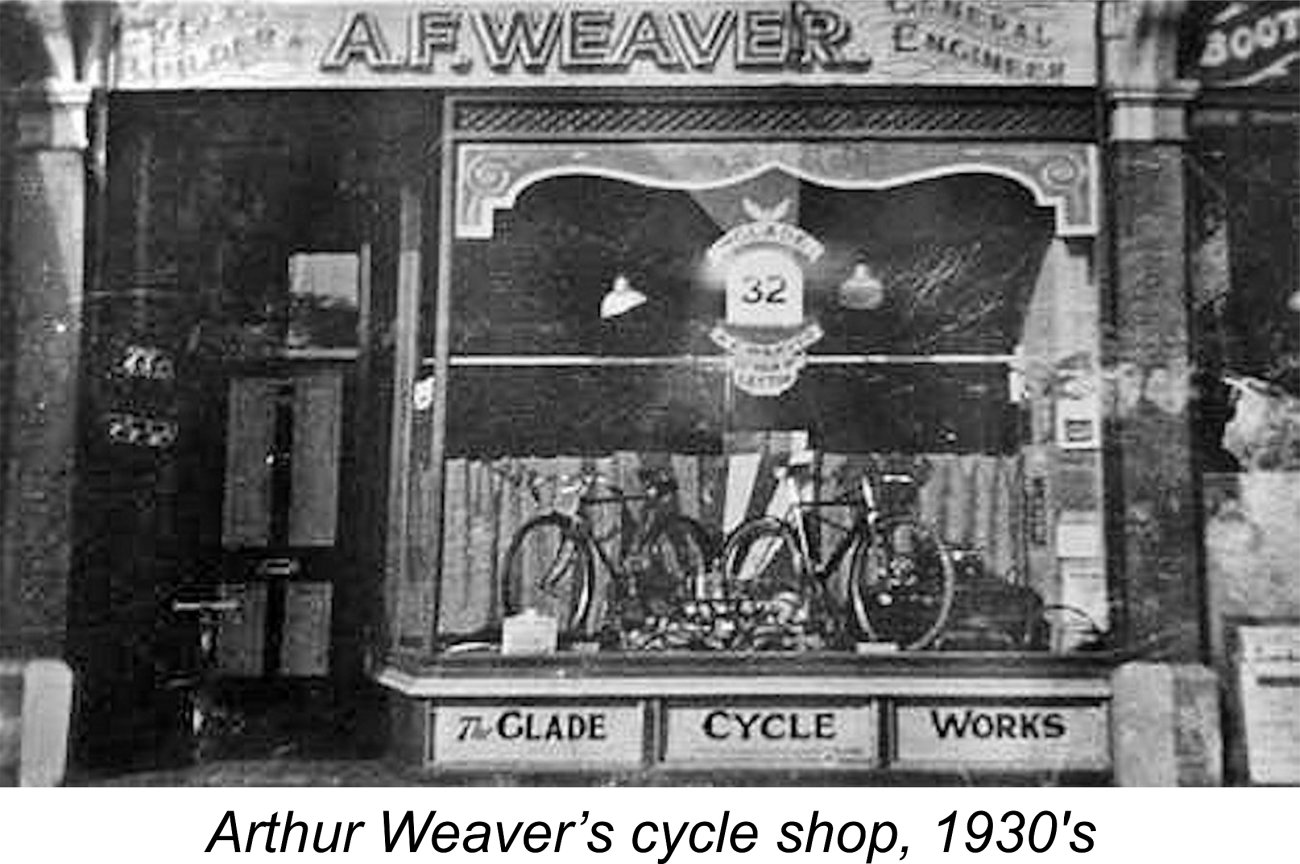 Arthur grew up in Leytonstone, a former village to the north-east of London which has now been swallowed up by Greater London. He attended a technical school for a few years, after which he went to work as a toolmaker. However, his major passion at this time was cycles and cycle racing. He was an active member of the Glendene Cycling Club and by his mid-twenties he had started his own cycle building business at 597 Leyton High Road, very close to his home on Farmer Road in Leytonstone. This establishment bore Arthur's own name but went by the subsidiary name of the Glade Cycle Works, defining its expertise as "cycle builders and general engineers". Custom racing bicycles were a speciality.
Arthur grew up in Leytonstone, a former village to the north-east of London which has now been swallowed up by Greater London. He attended a technical school for a few years, after which he went to work as a toolmaker. However, his major passion at this time was cycles and cycle racing. He was an active member of the Glendene Cycling Club and by his mid-twenties he had started his own cycle building business at 597 Leyton High Road, very close to his home on Farmer Road in Leytonstone. This establishment bore Arthur's own name but went by the subsidiary name of the Glade Cycle Works, defining its expertise as "cycle builders and general engineers". Custom racing bicycles were a speciality. 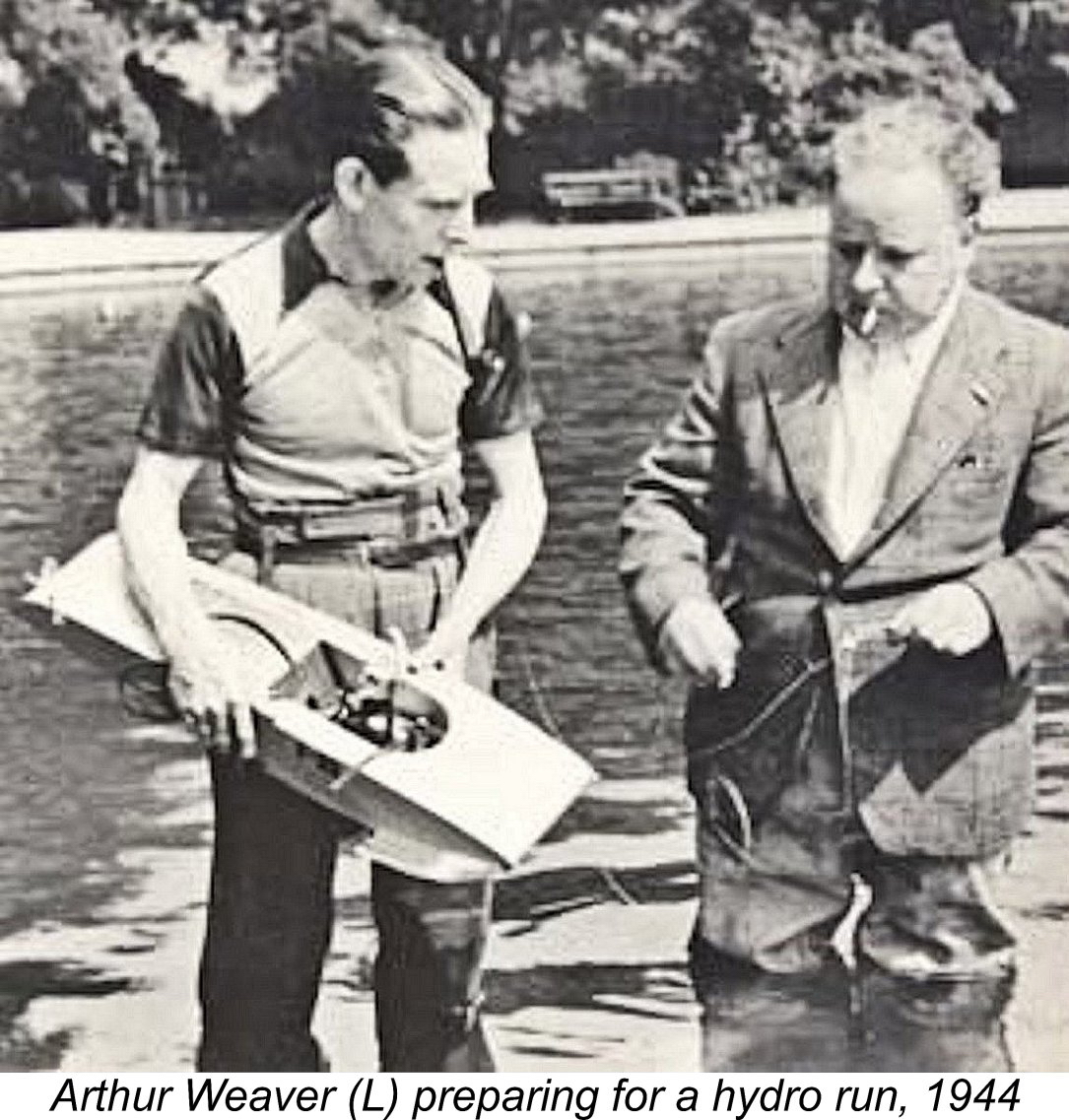 The onset of WW2 in 1939 brought an end to Arthur’s period of self-employment. As a trained and experienced toolmaker, he was placed in the “reserved occupation” category, which meant that he was not called up but was instead assigned to participate in war production work at the Planet Jig and Tool Company in Colindale, a little to the north-west of London. A house in nearby Hendon which had been requisitioned by the government came with the job, and Arthur moved his family there at this time to be close to his new workplace. It was during the war years that Arthur first became involved with tethered hydroplanes during his spare time.
The onset of WW2 in 1939 brought an end to Arthur’s period of self-employment. As a trained and experienced toolmaker, he was placed in the “reserved occupation” category, which meant that he was not called up but was instead assigned to participate in war production work at the Planet Jig and Tool Company in Colindale, a little to the north-west of London. A house in nearby Hendon which had been requisitioned by the government came with the job, and Arthur moved his family there at this time to be close to his new workplace. It was during the war years that Arthur first became involved with tethered hydroplanes during his spare time.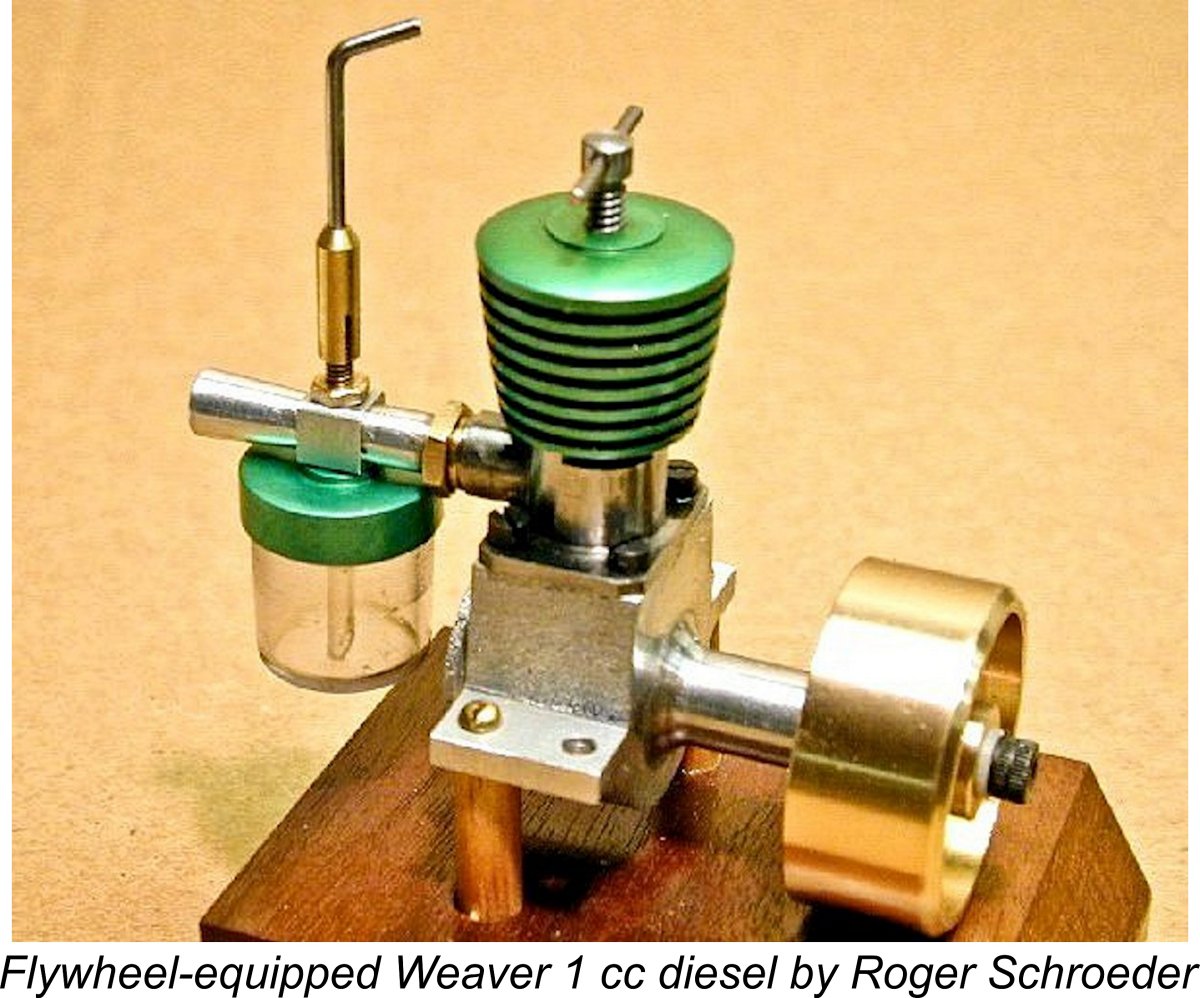 The design was initially known as the "Weaver/Ransom" after the designer and draftsman respectively. However, the engine is universally and appropriately known today as the Weaver 1 cc diesel to recognize its designer. Bore and stroke of this neat little unit are 0.408 in. (10.36 mm) and 0.452 in. (11.48 mm) respectively for an actual displacement of 0.969 cc (0.059 cuin.).
The design was initially known as the "Weaver/Ransom" after the designer and draftsman respectively. However, the engine is universally and appropriately known today as the Weaver 1 cc diesel to recognize its designer. Bore and stroke of this neat little unit are 0.408 in. (10.36 mm) and 0.452 in. (11.48 mm) respectively for an actual displacement of 0.969 cc (0.059 cuin.). 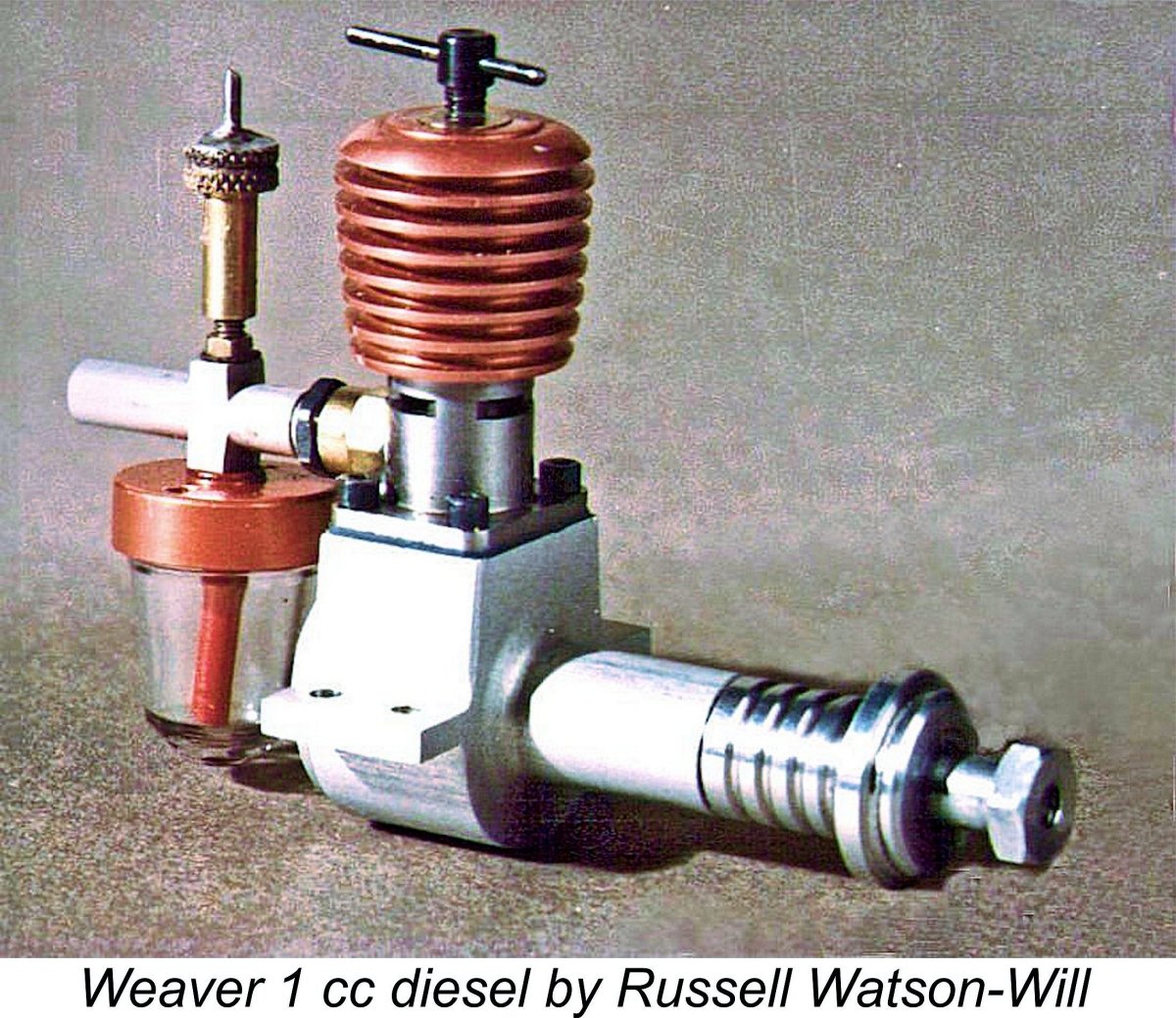 flight field - that is, starting on the first flip and swinging a large prop at whatever rpm the flier wanted, from a powerful two-stroke to a comfortable, under-compressed, rich low-rpm four-cycle”.
flight field - that is, starting on the first flip and swinging a large prop at whatever rpm the flier wanted, from a powerful two-stroke to a comfortable, under-compressed, rich low-rpm four-cycle”. 
